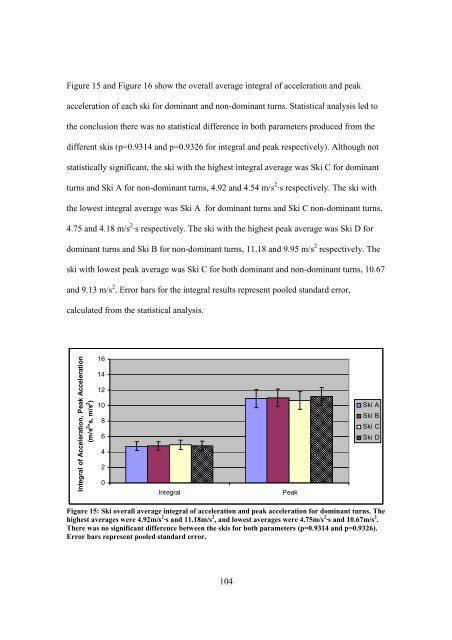Biomechanical P ... Slalom Water Skiing R1.pdf - Atrium - University ...
Biomechanical P ... Slalom Water Skiing R1.pdf - Atrium - University ...
Biomechanical P ... Slalom Water Skiing R1.pdf - Atrium - University ...
- No tags were found...
Create successful ePaper yourself
Turn your PDF publications into a flip-book with our unique Google optimized e-Paper software.
Figure 15 and Figure 16 show the overall average integral of acceleration and peakacceleration of each ski for dominant and non-dominant turns. Statistical analysis led tothe conclusion there was no statistical difference in both parameters produced from thedifferent skis (p=0.9314 and p=0.9326 for integral and peak respectively). Although notstatistically significant, the ski with the highest integral average was Ski C for dominantturns and Ski A for non-dominant turns, 4.92 and 4.54 m/s 2·s respectively. The ski withthe lowest integral average was Ski A for dominant turns and Ski C non-dominant turns,4.75 and 4.18 m/s 2·s respectively. The ski with the highest peak average was Ski D fordominant turns and Ski B for non-dominant turns, 11.18 and 9.95 m/s 2 respectively. Theski with lowest peak average was Ski C for both dominant and non-dominant turns, 10.67and 9.13 m/s 2 . Error bars for the integral results represent pooled standard error,calculated from the statistical analysis.Integral of Acceleration, Peak Acceleration(m/s 2 *s, m/s 2 )1614121086420Integral PeakSki ASki BSki CSki DFigure 15: Ski overall average integral of acceleration and peak acceleration for dominant turns. Thehighest averages were 4.92m/s 2·s and 11.18m/s 2 , and lowest averages were 4.75m/s 2·s and 10.67m/s 2 .There was no significant difference between the skis for both parameters (p=0.9314 and p=0.9326).Error bars represent pooled standard error.104
















